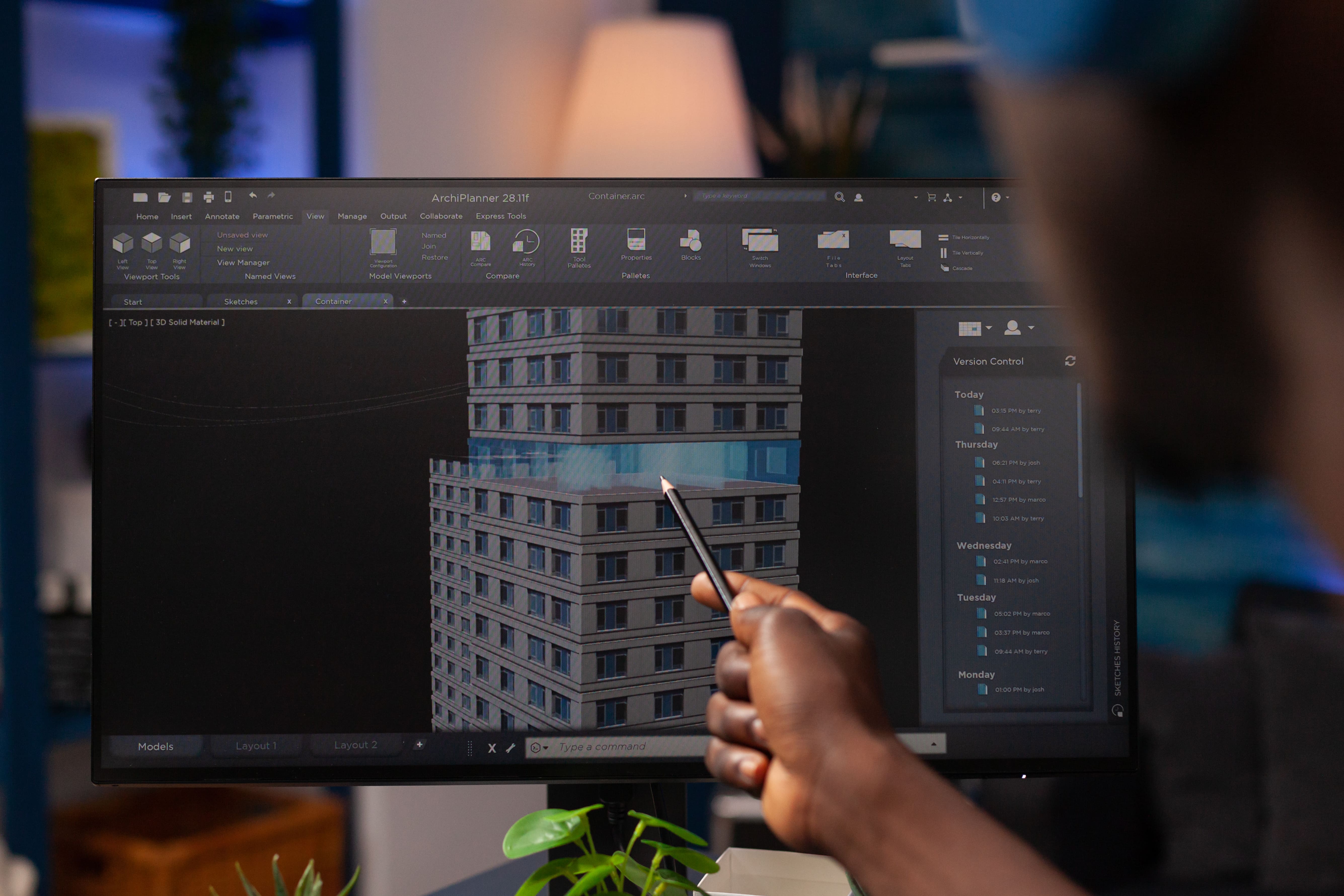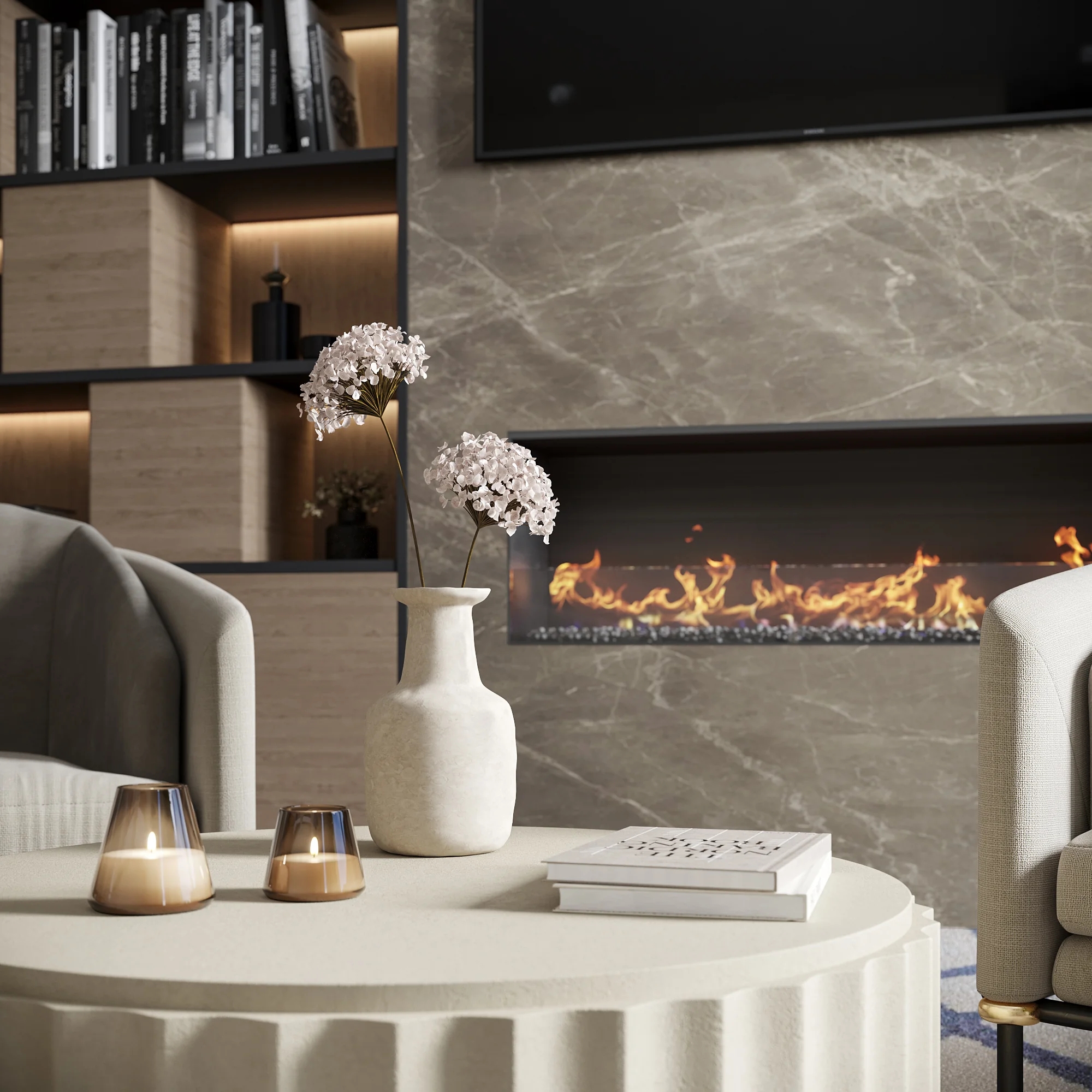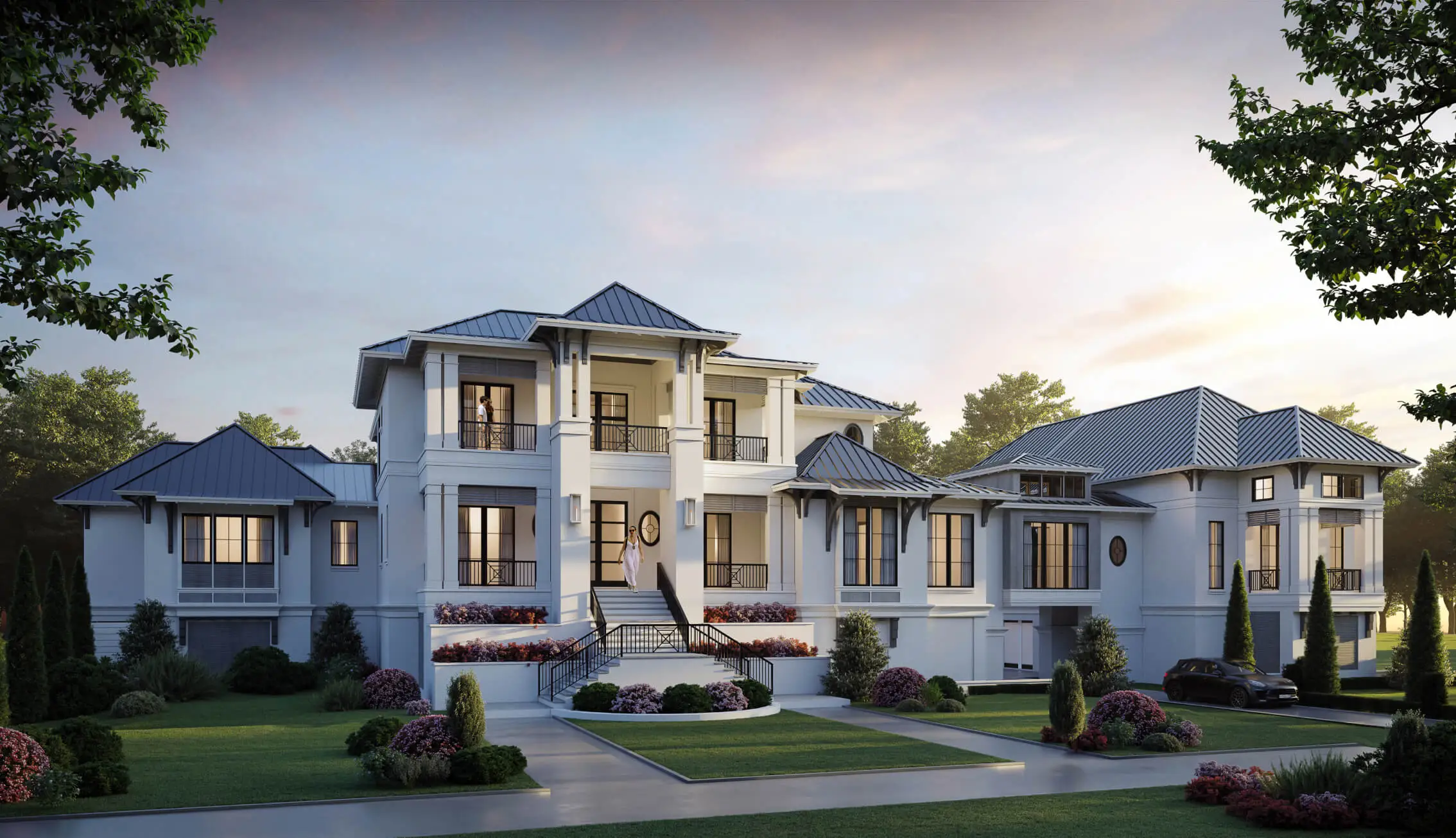Chasing photoreal on a budget—license-heavy software or tap a studio on demand? This guide shows you the best tool options in 2025 alongside real-world costs and when each option shines.
Interior designers today face a tough question: Should I invest in an in-house 3D rendering stack or outsource visualizations to a 3D rendering studio? For medium studios (with 3-5 in-house 3D experts) and solo professionals, the stakes are high. Interior design software licenses, hardware upgrades, training, and maintenance are not small expenses. At the same time, client expectations for photoreal visuals keep rising.
In this guide, I break down the top toolsets used (including us) for interior rendering in 2025 and share what they actually cost per year. This article sets out to give you the real-world pros and cons that can help you decide. We’ll also compare that investment to the cost and flexibility of outsourcing your rendering needs.
3d interior design rendering software ecosystem map
Before diving deeper into costs or workflows, it's helpful to understand how today’s most popular 3D tools connect and complement each other. The table below maps out key 3D rendering software for interior design used in interior design rendering—like who develops them, what they're used for, and how they integrate into a typical visualization pipeline.

3D rendering software for interior design: Our top picks
Choosing the right 3D interior design rendering software combo depends on what you value most—speed, realism, flexibility, or affordability. Here are the top toolsets interior designers rely on in 2025, and what each pairing or standalone tool actually does.
3ds Max + V-Ray or Corona: What they do together
3ds Max is your modeling base. It’s where you build out the interior—from walls and cabinetry to detailed molding and lighting layouts. It’s precise, flexible, and made for heavy-duty scene work.
But to turn those models into polished, realistic images, you’ll need a rendering engine. That’s where V-Ray or Corona come in.
V-Ray is highly customizable and supports fast GPU rendering. Corona is simpler, focused on still images, and runs on CPU. You’ll only use one renderer per seat—both plug directly into Max.
So in this combo: Max builds the space, and V-Ray or Corona light and render it to a photo-real level.
The typical render time for V-Ray vs Corona is as follows:
- 4K photorealistic interior in V-Ray: 1-3 hours
- Corona: Slower, CPU-based; expect 2-8 hours unless using denoising + distributed rendering
Real-world use cases & workflow
- Project type: High-end residential interiors, hospitality lobbies, commercial fit-outs
- Workflow: CAD import (DWG/Revit) → Scene modeling in 3ds Max → Texturing/Lighting → Rendering via V-Ray or Corona → Post in Photoshop/After Effects
- Typical output: 4K photoreal stills, cinematic fly-throughs, moodboard shots with natural lighting
Budgeting
Let’s now crunch the numbers to see if the 3ds Max + V-Ray/Corona investment is worth it. Here we provide a ballpark cost estimate for setting up the required tech stack, including software fees and hardware cost (for hardware, I’ve provided the figures for the mid-tier station).

Summary
In short, this tool combo and investment make the most sense for mid-sized interior design studios with a steady project pipeline that requires realistic 3D visuals on a monthly basis; or for those offering 3D visualization as part of their service suite in close collaboration with developers or architects.

SketchUp + Enscape: What this combo does
SketchUp is great for quick modeling. You use it to block out interiors, arrange furniture, and test layouts without overcomplicating things. Most interior designers already know their way around it.
On its own, though, SketchUp’s visuals are flat, but some of SketchUp’s premium packages offer V-Ray as part of the subscription. This means you already get V-Ray’s rendering engine for photorealistic output, without having to buy a separate V-Ray license.
However, most architects prefer to use SketchUp in conjunction with Enscape.
Enscape runs inside SketchUp and instantly turns your design into a lit, walkable scene. You can tweak materials, simulate lighting, and export stills or VR-ready tours in a few clicks.
You model in SketchUp, and Enscape takes care of real-time rendering and presentation. It’s fast, intuitive, and ideal for design reviews or moodboards.
The typical render time:
- HD stills: 15 seconds to 2 minutes
- 360° panoramas: Under 5 minutes
- VR walkthroughs: Real-time, buttery smooth
Real-world use cases & workflow
- Project type: Residential renovations, commercial fit-outs, design consultation proposals
- Workflow: SketchUp modeling → Material tweaks and scene setup in Enscape → Live client walkthrough or still export → Optionally polish in Photoshop
- Typical output: HD stills, 360° views, VR-ready walkthroughs
Budgeting
Time for calculations…
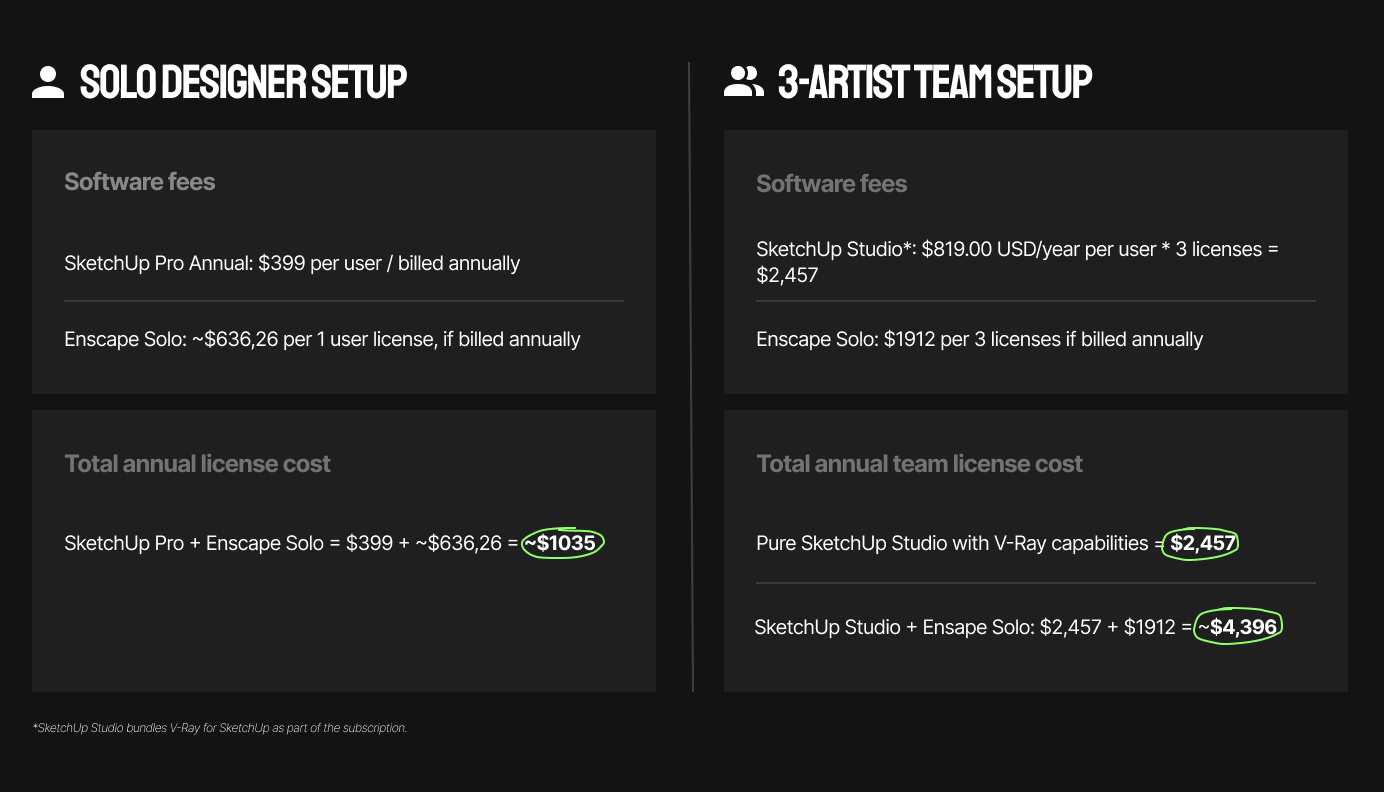
And to clarify a few things: although we listed Enscape Solo in the cost estimate for a small archviz team, we believe SketchUp Studio (bundled with V-Ray) may be a more cost-effective option for quick client presentations with a decent level of detail.
Summary
The SketchUp + Enscape works perfectly for interior designers needing fast visuals for iterative feedback and live client walkthroughs.
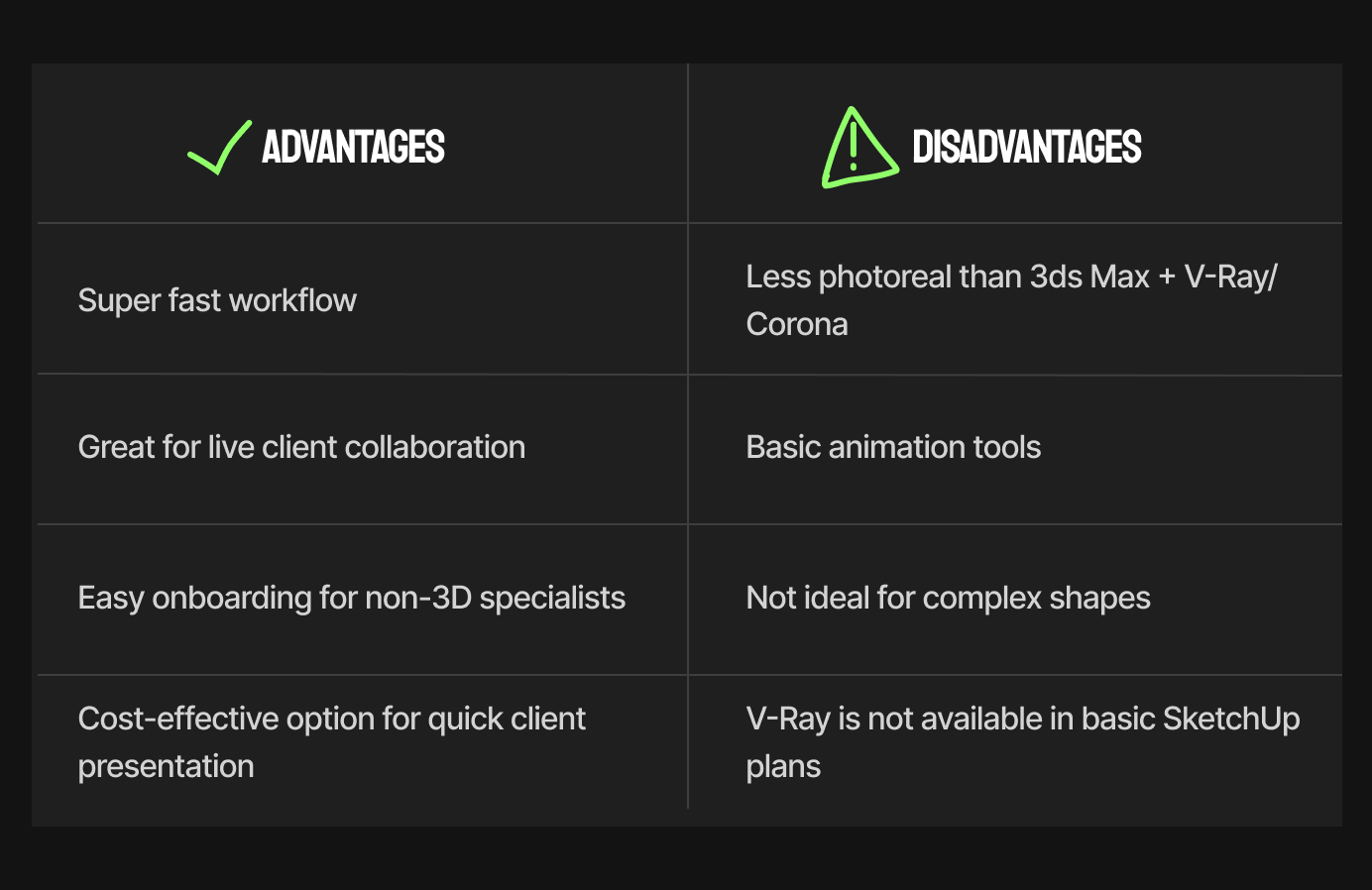
Blender (with Cycles + add-ons): What it does on its own
Blender is a full pipeline in one package. You can model, texture, light, render, and even animate—all without leaving the app.
Its Cycles renderer handles photoreal lighting and materials, and supports both CPU and GPU. It’s as capable as commercial renderers,, just without the price tag.
If you're comfortable with 3D basics and willing to learn a new interface, Blender can handle everything in one place, no plug-ins or external tools needed.
Typical render time:
- 2K still in Cycles: 1-3 hours
- Eevee preview: Instant, which is great for fast feedback
Real-world use cases & workflow
- Project type: Boutique interiors, furniture design previews, passion projects
- Workflow: Modelling (from scratch or imported from CAD/FBX) → Texturing using Principled BSDF → Lighting setup (HDRI + emitters) → Cycles render → Compositing in Blender or GIMP
- Typical output: 2K-4K stills, basic fly-throughs, animated reveal videos
Budgeting
Blender is considered free software, but let’s see if that’s entirely true.
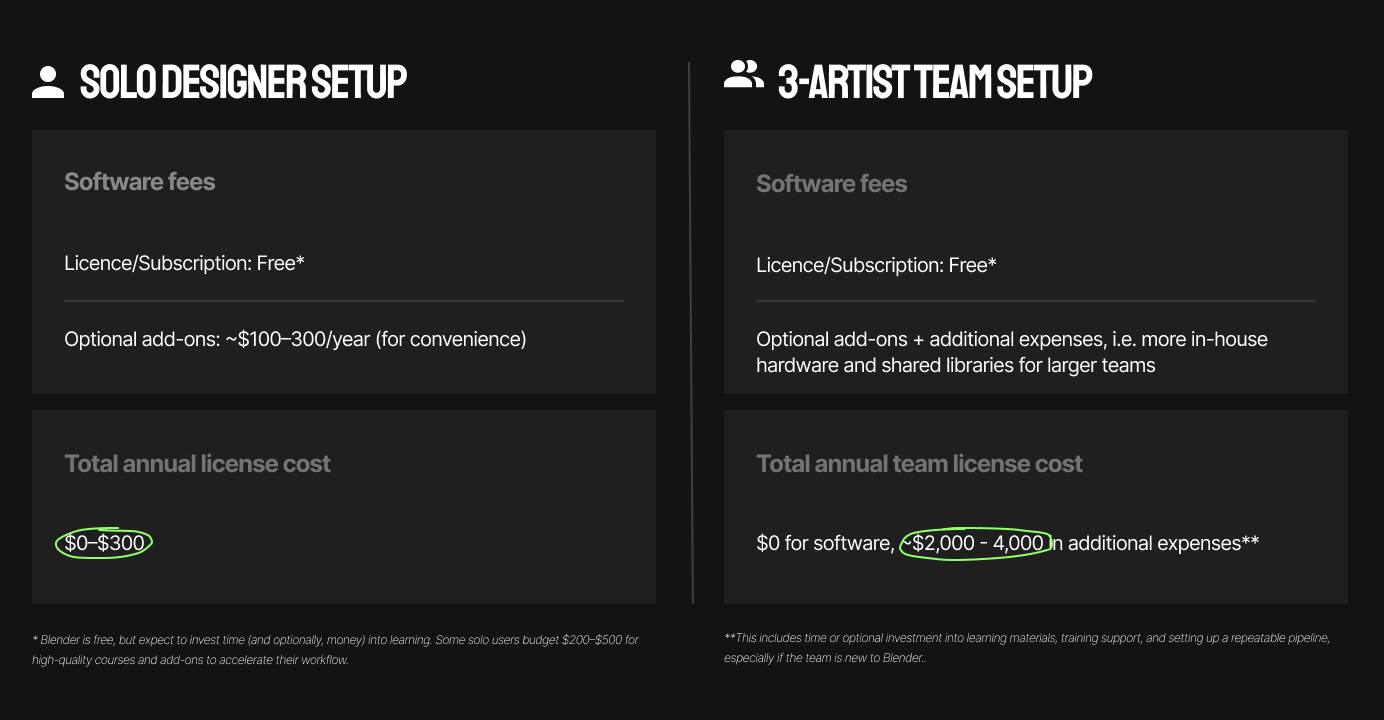
Summary
Best for freelancers or DIY studios wanting to eliminate interior design rendering software costs without sacrificing quality. Blender is great if you’d rather trade money for learning.
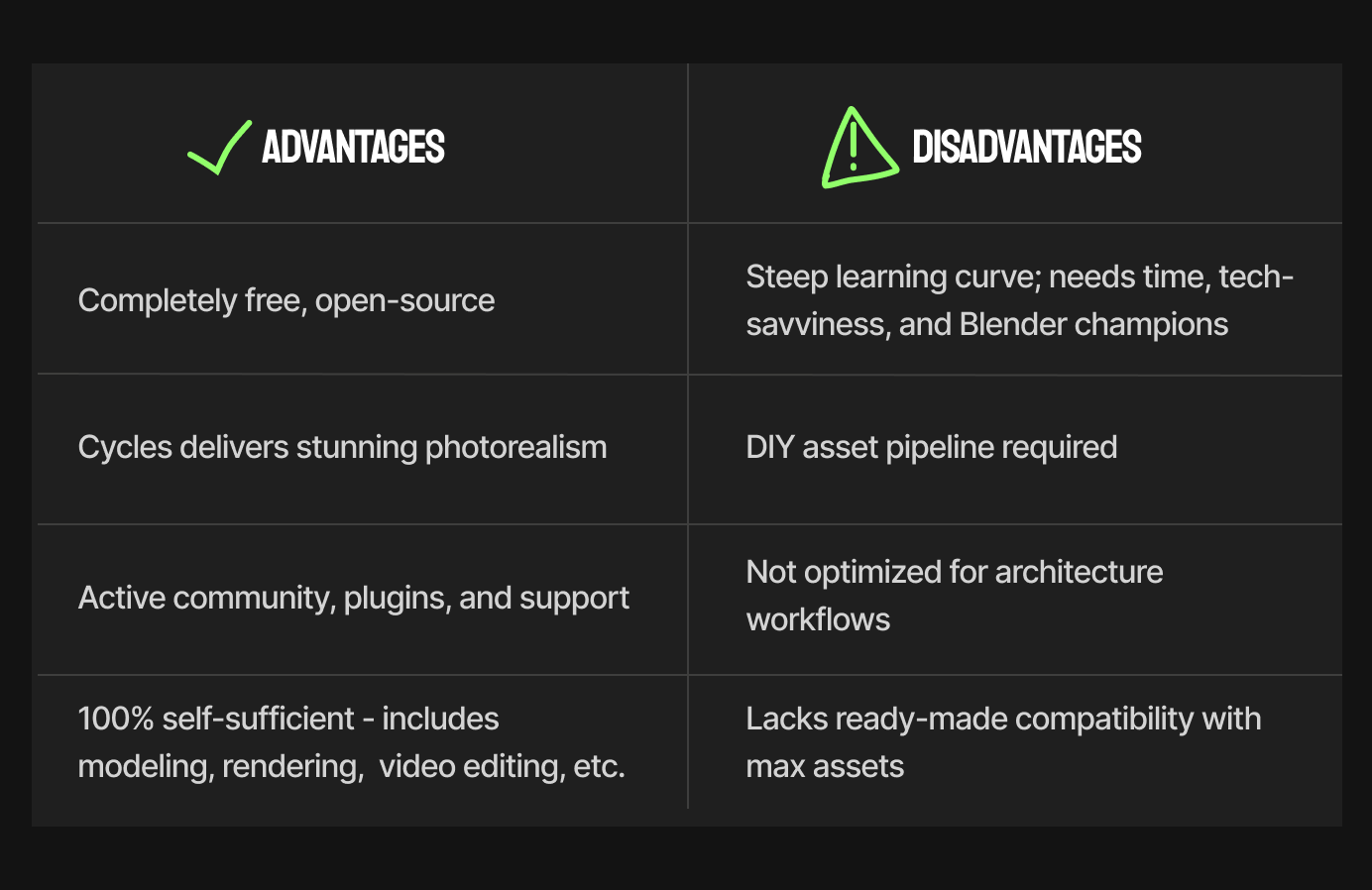
Unreal Engine 5: Post-production powerhouse
Unreal Engine is best thought of as a post-production layer in your workflow—it's the place where finalized 3D models are turned into interactive tours, real-time walkthroughs, or cinematic animations.
You still need to model your interiors elsewhere (SketchUp, Blender, Revit, etc.), but once that’s done, one technically skilled artist can usually bring it all into Unreal and polish it for client delivery.
Popular UE5 combos
Here are the most popular UE5 pipeline options:
Real-world use cases & workflow
- Project type: High-end real estate sales tools, luxury walkthroughs, interactive configurators
- Workflow: Import assets (from SketchUp/Blender/3ds Max) → Scene assembly → Lighting with Lumen → Interactive controls via Blueprints → Package as EXE or Web viewer
- Typical output: Interactive desktop app, VR tour, or cinematic video
Team structure
In a small studio, you don’t need a dedicated team for Unreal. You need one person (freelancer, staff, or part-time contractor) who’s comfortable with:
- Importing models via Datasmith or FBX
- Setting up Lumen lighting
- Applying materials
- Creating cameras and walkthrough paths
- Packaging scenes for interactive use, video, or VR
Some studios train an existing designer or visualizer to take on this role; others hire out.
Budgeting
Assuming the Unreal workflow can be managed by a single specialist, here's a rough cost estimate for setting up this tool in-house:
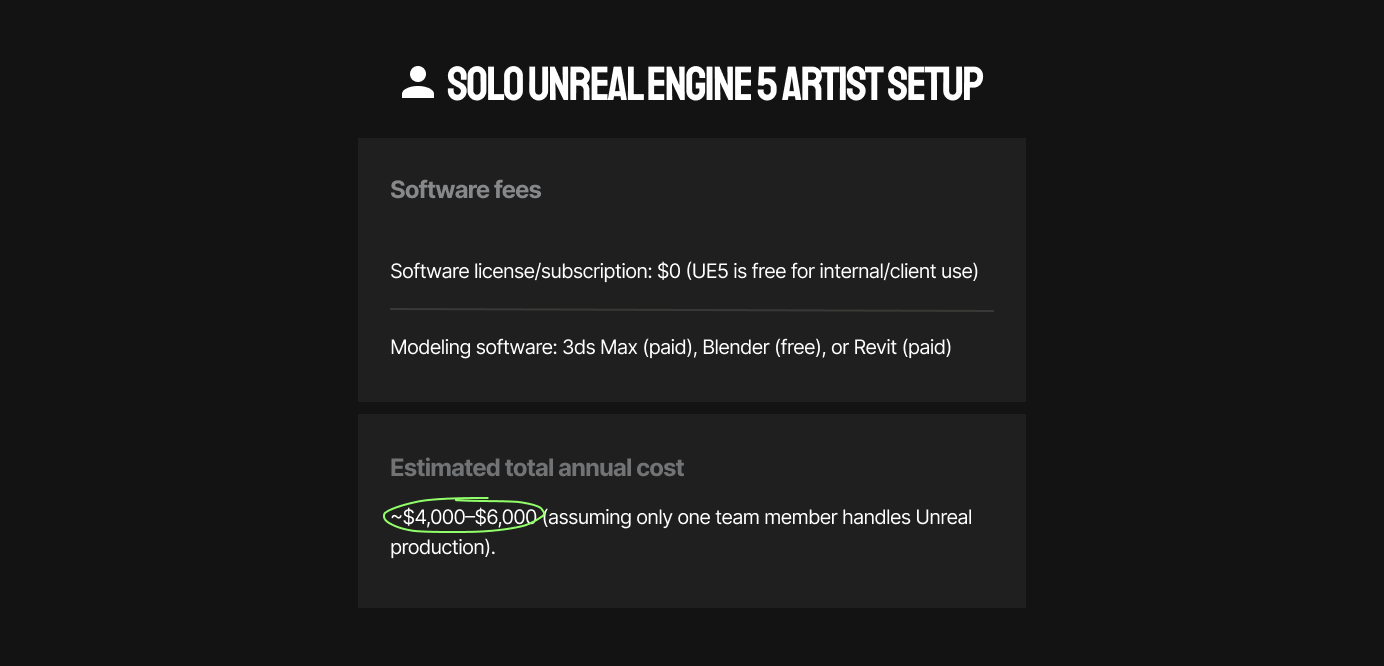
Summary
All in all, UE5 is perfect for polishing your interior renderings, which is great for client walkthroughs, immersive marketing, and advanced interactivity. But unless you have a steady production pipeline or large-scale projects, the overhead costs might outweigh the benefits.

Deciding on the best 3D rendering software for interior design
Not all tools cost the same, and not all costs are upfront! Here's what to keep in mind when deciding whether to build your 3D pipeline in-house or outsource it.
If you’re a solo designer:
- SketchUp + Enscape is your best bet for speed, simplicity, and solid visual quality
- Blender delivers pro-level results for free, if you’re ready to invest time in the learning curve.
- 3ds Max + V-Ray makes sense if high-end visuals are your main offering; otherwise, outsourcing might be the smarter move.
- Unreal Engine can be overkill, where the overhead often outweighs the benefits. If you're after cinematic visuals, consider outsourcing post-production to a 3D interior rendering studio.
If you’re a small studio (3-5 people):
- SketchUp + Enscape is the sweet spot for collaboration and fast turnaround.
- Blender can scale for free, but it needs at least one Blender-savvy team member.
- 3ds Max + Corona is more budget-friendly than V-Ray and works well for static render production.
- Unreal Engine is great for immersive presentations, but requires serious hardware and a learning commitment; you can consider outsourcing to avoid the unnecessary overhead.
To sum up everything we’ve discussed above, here's a quick breakdown of the four most common stacks used in interior design, and where the real cost sits for each.
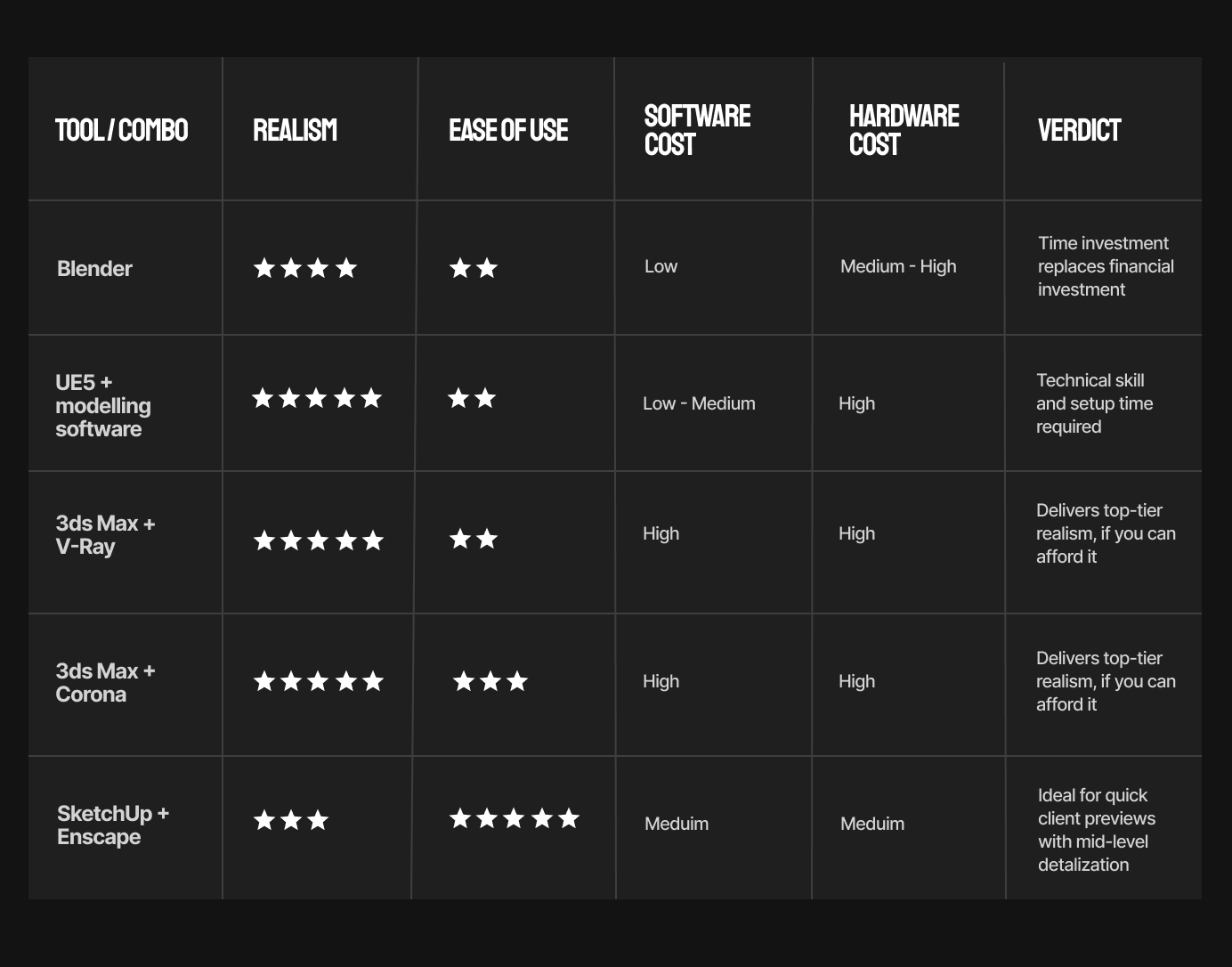
One workstation to run them all: Hardware cost
If you're planning to run 3ds Max + Corona/V-ray or SketchUp + Enscape, alongside Blender (Cycles), and Unreal Engine 5 on a single workstation, you'll need a machine that balances modeling speed, real-time rendering, and GPU-based ray tracing.
The sweet spot should look like this:
- Intel Core i9 or AMD Ryzen 9 CPU
- NVIDIA RTX 4080 or 4080 Super GPU
- 64GB RAM
- 1TB NVMe SSD
- Windows 11 Pro
This setup should cover everything from real-time VR and high-res Cycles rendering to heavy UE5 scenes with Lumen lighting and interactive tours.
Here are 4 workstation options from reputable U.S. sources, tailored to fit the high-performance criteria (Ryzen 9/i9, RTX 4080-level GPU, 64 GB RAM, NVMe SSD) you need for robust 3D rendering workflows:

Hardware budget range
Here are our hardware cost assumptions for a solo designer setup:
- Budget / Refurb: $1,600-1,800
- Mid-tier new rig: $2,700-3,000
- Enterprise setup: $4,500-5,000
Assuming each artist uses a mid-tier workstation, here’s a rough estimate of the one-time hardware investment for a team of three 3D visualization artists:
.png)
So the total hardware + OS (team of 3) cost will be approximately ~$8,700-10,500 one-time investment (or slightly less if buying refurbished or if OS is bundled).
Summing up
Considering the high total cost of ownership for advanced tools like 3ds Max, Corona, or V-Ray, the steep learning curve of free interior design software, such as Blender, and the hardware investment required for a solo 3D artist or a small team of three, many studios find a hybrid approach smarter. You can handle concept-stage visuals in-house and outsource final renders.
Need help with final renders? My team provides 3D architectural rendering services and will handle the heavy lifting so you can focus on design.


